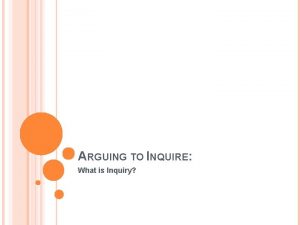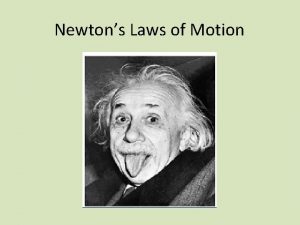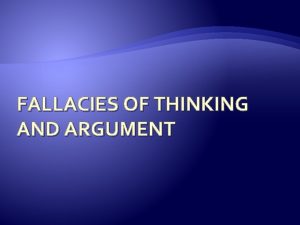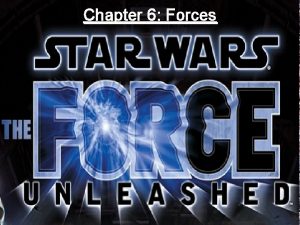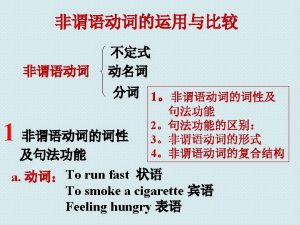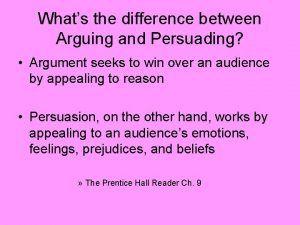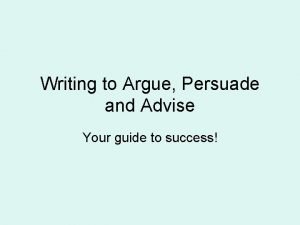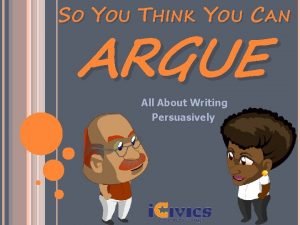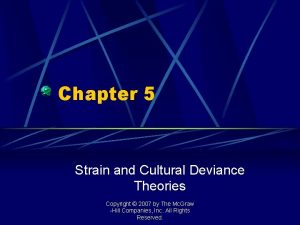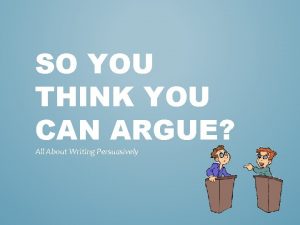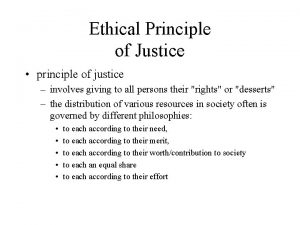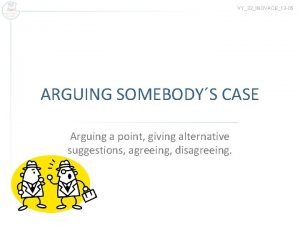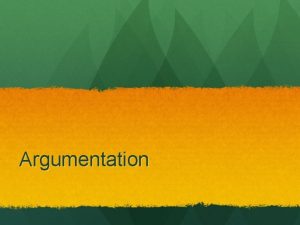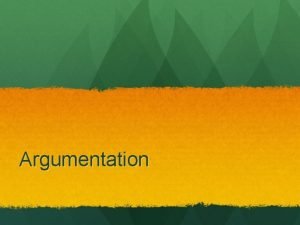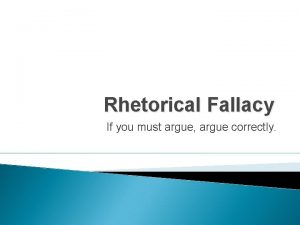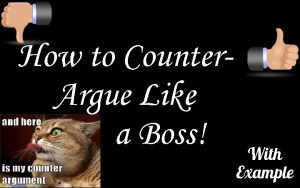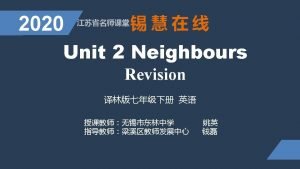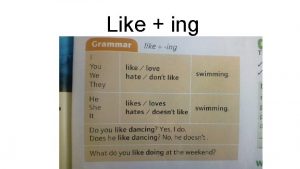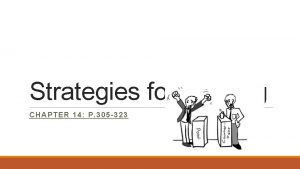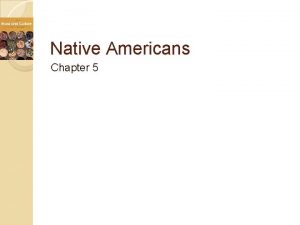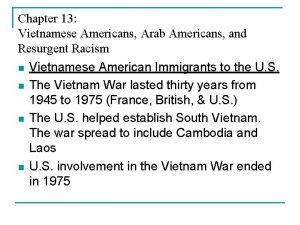Chapter 11 Arguing Americans like to argue Americans






















- Slides: 22

Chapter 11 Arguing

Americans like to argue. Americans like to win arguments.

For academic writings especially, writers must avoid emotional outbursts and convince readers their points -of-view are valid and rational.

A careful consideration of the audience is necessary when writing an argument.

Written argument creates an atmosphere of reason. Written argument needs to convince rather than alienate an audience.

Techniques for Writing Argument § Argument begins with a debatable issue – Examines more than one or two sides by considering the various stake-holders in the issue. – Anticipates what opposing side will present. – Evaluates conflicting positions. § Written argument focuses on: – – – The rhetorical situation A debatable claim A fair and accurate representation of the opposing view Reason and logic Sufficient evidence to support the claim

Claims for Argument § § Claims of fact Claims of cause and effect Claims of value Claims of solutions and policies

Appeals for Argument § Appeal to Reason (logos) – Scientific method § § § Appeal to Sense of Fair Play (ethos) Appeal to Emotion (pathos) Combine Appeals—but balance appropriately for your audience and topic.

Rogerian Argument § Based on understanding and compromise – Opens door for communication. – Go for a Win result. § The writer must be willing to examine and even change beliefs. § The writer is seeking to get readers to see what they have in common with each other and with other stake-holders in an issue.

§ Rogerian Strategies work especially well in sensitive and controversial issues – Avoids a confrontational stance. – Establishes common ground. – Demonstrates a willingness to change views. – Argues directly toward workable solutions that all sides can buy into.

Toulmin Model § Stephen Toulmin § Six Parts – Claim – Grounds – Warrant – Backing – Qualifier – Rebuttal

Claim: the position or claim being argued for; the conclusion of the argument. Data (or Grounds): reasons or supporting evidence that bolster the claim. Warrant: the principle, provision or chain of reasoning that connects the grounds/reason to the claim. Backing: support, justification, reasons to back up the warrant. Rebuttal/Reservation: exceptions to the claim; description and rebuttal of counter-examples and counter-arguments. Qualifier: specification of limits to claim, warrant and backing. The degree of conditionality asserted.

Data Claim Warrant

DATA Claim Warrant (Backing)

Rebuttal DATA Claim Counter-Argument Warrant (Backing)

Toulmin Model § Not everyone will find the same warrant statements. § Identifying the Toulmin model is more important when – readers are likely to disagree with the claim. – the claim is based on empirical facts more than values, precedence, or ethics. § Helps communicate by being reasonable and logical.

The Process § Choose subject – Must have more than 2 positions possible, or more than two stake-holders in the issue. § Collect data – Narrow and focus – Consider claim § Shape – Show the issue from the points-of-view of the three or more stakeholders you’ve found.

Outline § Introduction—Establish significance; establish essay map; connect to readers. § Presentation (I) Narration – give background (II) Partition – state thesis or claim (III) Argument – make argument; give evidence; show connection (IV) Refutation – show opposing views and give rebuttal or qualification. Repeat items I-IV as needed to cover your sub-claims. § Conclusion – summarize; suggest a solution; Ask for action or decision.

Develop Argument § Think of argument as a series of “because” statements. – Restatement supported by evidence, statistics, testimony, expert opinion. – Specific examples from experience and sources.

Writing Argument § Draft – Consider word choices and organization – Start with a working order or sequence – Make an outline § Revise – Check for word choice – Grammar and mechanical errors

Fallacies § Fallacies in logic destroy rational appeal and open argument to logical rebuttal § Fallacies in logic lessen your credibility and thus reduce effect of your main claim.

Fallacies § § § § § Hasty generalization Post hoc ergo propter hoc Genetic fallacy Begging the question Circular argument Either/Or Faulty comparison or analogy Ad hominem Ad populum Red herring or straw man
 Mac and tosh are arguing in the cafeteria
Mac and tosh are arguing in the cafeteria Mac and tosh are arguing in the cafeteria
Mac and tosh are arguing in the cafeteria Arguing to inquire
Arguing to inquire Calvin and hobbes arguing
Calvin and hobbes arguing Thank you for arguing
Thank you for arguing Mac and tosh are arguing in the cafeteria
Mac and tosh are arguing in the cafeteria Hypothesis contrary to fact
Hypothesis contrary to fact While driving anna litical
While driving anna litical It's no use arguing
It's no use arguing Jay heinrichs thank you for arguing
Jay heinrichs thank you for arguing Arguing and persuading
Arguing and persuading Argue and persuade
Argue and persuade Purpose to inform persuade or entertain
Purpose to inform persuade or entertain Touching spirit bear study guide
Touching spirit bear study guide So you think you can argue
So you think you can argue Ap style plays
Ap style plays What does james madison argue in federalist 10
What does james madison argue in federalist 10 Culture conflict theory
Culture conflict theory You can argue
You can argue Principle of justice
Principle of justice Fletcher argue building
Fletcher argue building So you think you can argue
So you think you can argue Some may argue that
Some may argue that


